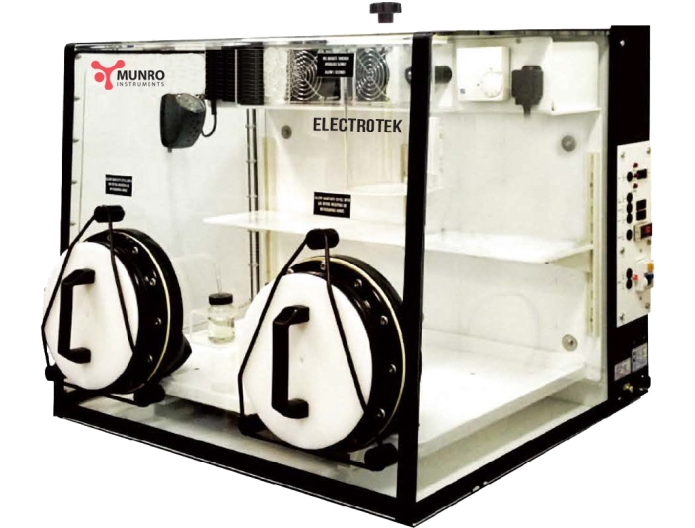Cells have been cultured for decades to study bacterial and eukaryotic cell biology and to create and test disease therapies. When developing cells, it is frequently important to replicate their physiological environment.
A range of oxygen concentrations in animal cells in vivo, ranging from 1% to 12%. An atmospheric concentration of oxygen of 21% is normal under normal conditions. Oxygen hinders many anaerobic microbes' metabolic activities. These cells are frequently hazardous when exposed to high oxygen levels.
Scientists have created chambers that promote the growth of bacterial and eukaryotic cells, enhancing their understanding of their physiological roles and facilitating the development of new disease therapies.
Both eukaryotic and prokaryotic species can be examined under physiologically realistic circumstances in anaerobic growth chambers and hypoxia gloveboxes. Anaerobic growth chambers and hypoxia chambers are similar in their construction and function, but they employ distinct processes for eliminating oxygen. Researchers can investigate and create innovative cures for illness, manufacture biofuels, and perform bioremediation studies using these glove boxes.
Use of both the boxes
It has been almost fifty years since anaerobic growth chambers and laboratory glove boxes were created to research the development of anaerobic bacteria, which do not require oxygen. In addition to being airtight, these chambers provide glove apertures for simple sample manipulation access. This chamber typically has oxygen concentrations between 0 and 5 parts per million. By performing a chemical reaction with the aid of a catalyst material (usually palladium), ambient oxygen is extracted.
It is often necessary to use an airlock to introduce samples, reagents, and media into gloveboxes in order to maintain low oxygen concentrations. Temperature impacts the development and metabolism of these organisms; hence temperature controls are also provided. As oxygen-rich gas travels via airlocks, entry into the cabin is denied. In research, microorganisms in their natural habitat play a crucial role. Medical advancements, biofuels, bioremediation, and the discovery of new drugs have all been made possible by anaerobic growth chambers.

Biofuels and clinical diagnostics are two instances of cutting-edge biological research being undertaken as a result of the utilization of anaerobic chambers. Due to the strength of microorganisms found in anaerobic conditions, scientists may now find genes that can be utilized to produce bio-diesel to replace fossil fuels in an eco-friendly manner. These bacteria are managed and cultivated in anaerobic chambers to produce fuel depending on the metabolic processes that occur inside them. They are able to produce fuel as a byproduct of their metabolic activities. There are several harmful bacteria that grow anaerobically, necessitating the use of chambers to cultivate and investigate these microbes for potential therapeutic uses.
As tissues grow in vivo, they are usually grown in hypoxic conditions. To study eukaryotic cells in tissues under circumstances that are physiologically relevant, hypoxic glove boxes were developed. Moreover, hypoxic conditions in mammals promote the growth of a variety of bacteria. Low-oxygen chambers are necessary for achieving natural development states. To simulate anaerobic growth chambers, it is possible to closely regulate the oxygen content in hypoxia chambers.

Hypoxia chambers, which mirror the oxygen setpoints encountered in anaerobic chambers, enable researchers to reach physiological conditions. By adding nitrogen and carbon dioxide into these airtight compartments, the level of oxygen in the environment may be adjusted. In order to maintain a user-specified oxygen level, nitrogen and carbon dioxide are continuously pumped.
These chambers are also controlled to maintain optimal growth conditions, including temperature and relative humidity. To achieve the desired conditions, hypoxia chambers must monitor oxygen more precisely and control other process gases more tightly than anaerobic growth chambers.
Best Glove Boxes/Anaerobic Chambers
1. CHAMBER - INCUBATE 220 PETRI DISHES
Incubation Capacity 220 Petri Dishes
Transfer Port Capacity 10 Petri Dishes
Gas Supply Mixed Gas 10% H2 + 10% CO2 +80% N2
Electrical Supply 240V.A.C., 50Hz, 300W

2.ANAEROBIC CHAMBER-INCUBATE 400 PETRI DISHES-DUAL GAS SUPPLY
Incubation Capacity 400 Petri Dishes
Interlock Capacity 60 Petri Dishes
Plus Single Petri Dish Entry System
Dual Gas Supply 1) Mixed Gas 10% H2 + 10% CO2 +80% N2 (Incubation & lock flushing
2) N2 (Lock flushing only)

3.ACRYLIC GLOVE BOX 875L X 480W X 500H MM
Material Plastic
Plastic Type PVC
Air Locker Chamber Size 230L x 230W x 230H mm
Containment Chamber Size 875L x 480W x 500H mm
Product Overall Size 1150L x 500W x 500H mm
Net Weight 21kg
Pressure Controller No

4.STAINLESS-STEEL GLOVE BOX 780W X 650D X 700H
Features:
● Bench-top transparent glove box offers larger inert gas
environmental workspace with vacuum air locker and
side door.
● The Glove box is made of transparent polycarbonate for
clear viewing from any angle.
